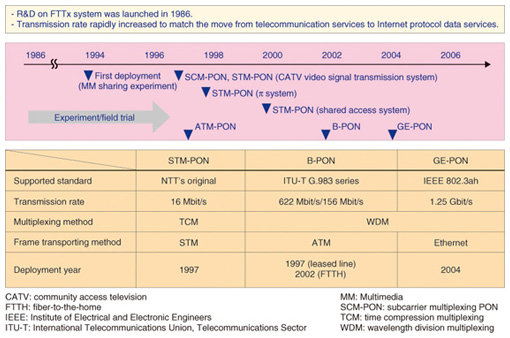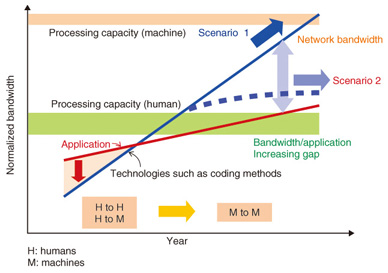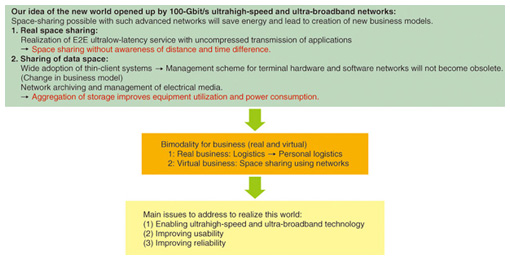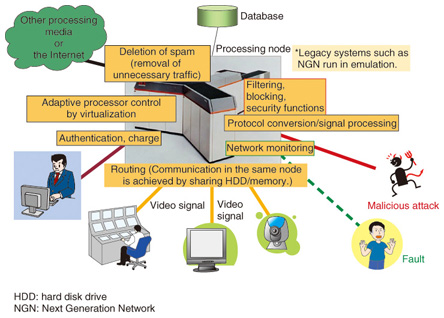 |
|
|
|
|
|
Feature Articles: NTT Tsukuba Forum 2013 Workshop Lectures Vol. 12, No. 3, pp. 54–59, Mar. 2014. https://doi.org/10.53829/ntr201403fa9  Structuring Future Access Network SystemsกกAbstractThe First Promotion Project initiated by NTT Access Network Service Systems Laboratories involves researching and developing optical access systems focusing on transmission devices. In this article, I introduce optical access transmission technologies that we have developed and also discuss a future optical access system that follows expected social and environmental changes. Keywords: access system, optical fiber transmission technology, R&D 1. Overview of R&D history at AS LabsThe research and development (R&D) history of transmission technologies at NTT Access Network Service Systems Laboratories (AS Labs) includes optical access, wireless access, and wide area Ethernet systems. We began R&D toward the commercial introduction of a passive optical network (PON), which is currently the basic representative technology of optical transmission systems, about 20 years ago. The PON available now was developed and commercially introduced as GE (Gigabit Ethernet) -PON about 10 years ago; it supports NTT EAST and WEST Group Companies’ FLET’S HIKARI services for general consumers. At around the same time, video transmission technology was commercially introduced, and it supports FLET’S television services. In light of the lessons learned from the Great East Japan Earthquake, we are now researching and developing wireless access communications technologies that will prevent the disconnection of lifeline services. Regarding corporate customer services, AS Labs’ wide area Ethernet ERP (Ethernet Ring Protection) and other technologies have been applied for Ethernet BEW (Business Ethernet Wide) services and are now in practical use. The R&D history of FTTx (Fiber-to-the-X) is shown in Fig. 1. As the figure shows, R&D on optical access systems is centered on high-speed and wide area services such as STM-PON (synchronous transfer mode PON), B-PON (broadband PON) and GE-PON. The number of customers of GE-PON-based optical fiber access services has reached about 18 million. STM-PON offers multiple lines including telephone, ISDN (integrated services digital network), and dedicated lines. The transmission speed was initially 50 Mbit/s, which is fast enough for low-speed legacy services such as PSTN (public switched telephone network). However, as time went by, the age of the Internet came, and we undertook R&D on B-PON systems based on ATM (asynchronous transfer mode). ATM made it possible to stream multiple transmissions of data and video. The transmission speed of this system is 155 Mbit/s, which enabled bandwidth-guaranteed networks and priority control.
About 10 years ago, we began R&D on the Ethernet-based GE-PON system. This system is now the most popular optical access system in Japan. It can provide high-speed and wide-area services. Some system providers offer the maximum speed of 1 Gbit/s. In this way, the technologies and products researched and developed by AS Labs have made it possible to steadily offer high-quality and low-cost services to customers. 2. PON transmission technologyIn this section, I review low-cost and low-energy-consumption PON transmission technology, and also discuss many other current and future services. The transmission scheme underlying multiple technologies, for example, STM-PON, B-PON, and GE-PON, is called time division multiplexing (TDM). In TDM, user data are interleaved and transmitted on a time axis. For down signals, data addressed to each ONU are placed on the time axis and transmitted from the optical line terminal (OLT) side; the optical network unit (ONU) picks up the data addressed to itself. With up signals, if the ONUs lie at different distances from the OLTs, the signals may collide at the splitter. Therefore, scheduling technology is applied in order to prevent such collisions. This technology measures the transmission delay time and adjusts the timing between OLTs and the ONUs. TDM has the advantage of being low cost compared to other multiplexing schemes, but it depends mainly on the performance of electrical devices and therefore limits the speeds that are possible. To increase the number of areas it can be applied to, we must consider increasing its speed and reach. One transmission scheme that avoids the issues of TDM is wavelength division multiplexing (WDM). WDM proactively uses light wavelengths. It can multiplex each user data element and each service on the time axis without data overlap. Because the transmission paths are logically separated, the interference between signals becomes virtually insignificant. For example, even if we limit the data bit rate to 10 Gbit/s per wavelength (matching the limitation imposed by commercial low-cost electrical devices), a 40-Gbit/s data stream can be sent by dividing the stream into four wavelengths, multiplexing them, and transmitting them simultaneously. The technology being investigated for the near term is frequency division multiplexing (FDM) transmission (Fig. 2). FDM offers a narrower wavelength interval than WDM. Separate wavelengths can be assigned to many services and users, so it enables network services to be provided without interference between users and services. Some challenges remain, however, including cost, before FDM will be commercially available. Nevertheless, FDM is a highly attractive technology from the viewpoint of the importance of optical fiber transmission.
3. R&D trendsHere, I discuss current R&D trends for optical access systems. The first thing to consider is that our vision of society continues to change, so I feel that we need to carry out R&D by considering four basic trends. The first trend is the rapid increase occurring in the speed and volume of communications including mobile systems. The traffic loads created by video systems will continue to explode as SD (standard definition) is replaced by HD (high definition) and SHD (super high definition) 4K/8K resolution. Future demands, however, include not only increased device speed and expanded reach, but also support of codec (codec/decoder) technology in order to satisfy various expected requirements such as those related to capacity and delay. The second trend is the growing need for FMC (fixed and mobile convergence) devices. For example, one challenging issue is determining how to achieve low-latency to satisfy online game users. The third trend is the emergence of service characteristics that are radically different from conventional services such as M2M (machine to machine) communication. For example, if we assume that one person has about 100 networked items, a new network technology that can support about 100 billion devices is needed just for Japan. The fourth trend involves examining ways to secure high-reliability connections to ensure that lifelines remain connected. The biggest challenge is determining how to design environmentally friendly networks that consume less energy, while achieving cost savings at the same time. An image of two trends in access network R&D is shown in Fig. 3. Scenario 1 illustrates the current communication technology trend; it focuses on achieving high speeds and wider usage areas. Scenario 2 reflects the more recent trend to deemphasize the need for higher speeds and wider areas. Currently, signs of scenario 2 are already appearing in some areas.
In the past, the communication line transmission speed was not high enough for attractive service applications. That is why R&D actively focused on improving the transmission speed. However, higher transmission speeds are not being targeted as much these days. Also, we have studied how much bandwidth communication lines must offer given the limitations imposed by the processing abilities of humans and machines. The processing ability of humans is quite limited, and network performance already exceeds it. From the viewpoint of transmission speed, the target should be to achieve a level of machine processing instead of human processing. Furthermore, we believe that higher speeds and wider areas are necessary only when targeting machines with high processing ability and low latency. It may be necessary to split the difference between scenarios 1 and 2. For example, for services offered directly to humans, the communication line quality should be focused on satisfying humans. This is already being carried out from the viewpoint of QoE (quality of experience) in some areas. 4. A new world realized by ultrahigh speed and ultralow latencyThe direction of optical access system development in the coming years should be toward future services or the image of society that we want to create. My idea of a new environment that can be realized by ultrahigh-speed and ultralow-latency systems is described in Fig. 4. Here, I explain what type of society can be created with 100-Gbit/s high-speed optical access systems. In this environment, ultralow-latency networks can be installed that dispense with compression or codec processing. With this approach, business areas will be aggregated and sorted into real businesses and virtual businesses. Real businesses such as commodity distribution will be directed toward personal commodity distribution, in which pinpoint services will be provided to each individual. In contrast, virtual businesses will be an enhanced version of businesses now present in the Internet world. The key point of this world is that high speeds and wide areas create a real society. Simply put, we can create a world in which people can have what they need delivered to them immediately if they have any kind of communication device such as a telephone. Furthermore, depending on the development of personal commodity distribution, businesses may ultimately involve only communications and distribution. Creating such a world is a bit questionable from the viewpoints of industry and the economy, but it is, I think, the ultimate goal of network services.
5. Future access network systemsAn image of what a future access network system should consist of is shown in Fig. 5. Recently, the term cloud (computing) has taken many meanings. It is expected that all of the data that users hold will basically be stored in the cloud in the future. Regarding data distribution, I imagine that data will be exchanged not between each user or device in real space but between cloud servers or virtual users, and users will be able to temporarily view the stored data. Ultimately, cloud servers will be integrated on single chips, and data distribution may be within a single chip. I think the current E2E (End to End) environment will shift to the environment that makes maximum use of the Internet: E2N2N2E (End to Network to Network to End).
The broadband market in Japan has already entered a saturated state. Because new and innovative technologies continue to be developed in the communication industry, the transmission technology market that supports broadband will most likely experience a downturn and will eventually shrink. In the coming years, I think that while the broadband market will be vitalized through the emergence of mobile systems with supreme usability, services and applications will be the main players in the market. As for transmission systems, however, we will not stop our quest for technological innovations and thus will need to continue to invest in them to improve the technology. Finally, I include three suggested contributions that we at NTT can make—either individually or collectively—as part of NTT’s overall mission. The first is to contribute to the company, which is rather obvious for one who belongs to a company. In addition to thinking of our research, we also need to think how we can secure profits for the whole NTT Group. The second is to contribute to society. This includes, for example, providing secure and stable connections in emergencies such as earthquakes or other disasters. Furthermore, we should contribute to the creation of a society wherein everyone can lead a comfortable life by being connected through networks and communications. The third is to contribute to industry. In the future, it will be important to develop new technologies that will vitalize other industries by not only conducting in-depth studies in particular areas but also by bringing the whole area of systems, services, and applications into view. At the same time, I think we need to design basic technologies based on new principles that are not simply extensions of existing technologies. As a result, I am aiming to make innovative changes to ensure that positive reinforcement defeats any negative spiral. 6. Future developmentsI think that access systems in the future will shift from the conventional high-speed and wide-area vision that supports services and applications, or the age of setting up the communication infrastructure base, to the age of ultrahigh volume and ultralow latency that targets different service characteristics or information in the wider dynamic range including M2M. On the basis of this vision, we will continue our R&D with the goals of easily staying connected whenever and wherever with whomever without disconnection in order to increase customer satisfaction, and business activation to increase industry performance; I think that this defines our mission. ProfileCareer highlightsGeneral Manager, 1st Promotion Project, NTT Access Network Service Systems Laboratories. Hideaki Kimura received the B.E., M.E., and Ph.D. degrees in electrical engineering from Hokkaido University in 1987, 1989, and 1992, respectively. In 1992, he joined NTT LSI Laboratories, Kanagawa, where he engaged in research on package design for 100-Gbit/s level high-frequency wideband ICs and high-sensitivity receiver module design for optical subscriber systems. From 1994 to 1996, he was at NTT Transmission Systems Laboratories, Kanagawa, where he engaged in research on economical systems such as LD transceivers and PD transceiver techniques. From 1996, he was engaged in researching super-low-power transceiver modules for the optical subscriber system, system design, and basic technologies such as 1V-operation-super-small-size ONUs and a no-power-supply voice communication service for blackout situations caused by disasters. From 2003 to 2005, he worked in the personnel department of NTT EAST. In 2006, he began researching future optical access network systems based on WDM and DSP. From 2010 to 2012, he was an Executive Research Engineer in the Research & Development Planning Section. He is a member of the Institute of Electronics, Information and Communication Engineers and IEEE. |
|













